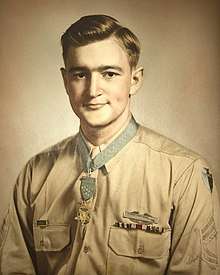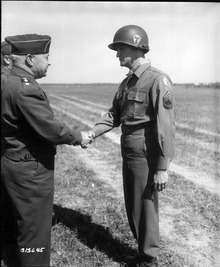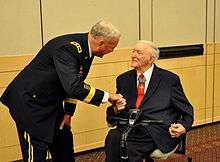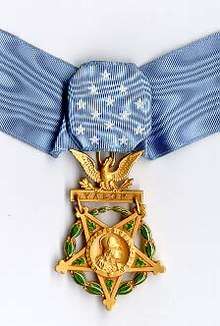Charles H. Coolidge
Charles Henry Coolidge (born August 4, 1921) is a former United States Army technical sergeant and a recipient of the United States military's highest decoration for valor—the Medal of Honor—for his heroism in France during World War II.
Charles H. Coolidge | |
|---|---|
 | |
| Born | August 4, 1921 Signal Mountain, Tennessee |
| Allegiance | United States |
| Service/ | United States Army |
| Years of service | 1942–1945 |
| Rank | Technical Sergeant |
| Unit | Company M, 3rd Battalion, 141st Infantry Regiment |
| Battles/wars | World War II |
| Awards | Medal of Honor Silver Star Bronze Star Medal Legion of Honor (France) |
Coolidge is the only living Medal of Honor recipient from the European theater of the war, and the only surviving one to receive the Medal of Honor during the war. Coolidge and Hershel W. Williams (Marine Corps, Pacific theatre, presented days after war's end, age 96 in 2019) are the only living Medal of Honor recipients from World War II.
Early life
Coolidge was born in Signal Mountain, Tennessee, on August 4, 1921, the son of Walter and Grace (McCracken) Coolidge of Chattanooga. He graduated from Chattanooga High School in 1939, and worked at his father's printing business as a bookbinder.
World War II

Coolidge was drafted into the United States Army on June 16, 1942.[1] He received basic training at Fort McClellan in Alabama. He was then sent to Camp Butler, North Carolina, and Camp Edwards in Massachusetts, where he was assigned to M Company, 3rd Battalion, 141st Infantry Regiment, 36th Infantry Division. In April 1943, his unit was shipped overseas to Oran in Algeria, to participate in the North Africa Campaign. While serving as a machine gun section leader and sergeant, he was awarded the Silver Star for gallantry in action in Italy on May 31, 1944.[2]
On October 24, 1944, Coolidge was a technical sergeant in charge of group of machine-gunners and rifleman of M Company who were to hold a vital hilltop position in France near the German border. During four days of attacks at Hill 623, east of Belmont-sur-Buttant in France, Coolidge and his group held off numerous enemy infantrymen, plus two tanks on October 27 using grenades; one tank unsuccessfully fired 5 separate rounds at Coolidge personally. For his actions above and beyond the call of duty during the battle, Coolidge was presented the Medal of Honor by Lieutenant General Wade H. Haislip during a ceremony at an airfield near Dornstadt, Germany.
Post-war life
Coolidge resides near Chattanooga, Tennessee, where a highway and park have been named for him. He still goes to work every day at the family business, Chattanooga Printing & Engraving,[3] which celebrated its 100th anniversary in 2010. His son, Charles H. Coolidge Jr., is a retired lieutenant general of the United States Air Force. On September 15, 2006, Coolidge was awarded the Legion of Honour by officials of the French consulate at a ceremony in Coolidge Park (named in 1945).[4]
Coolidge was inducted into the John Sevier Chapter of the Sons of the American Revolution in March 2015.[5]
Military awards
Coolidge's military awards and decorations include:[6]
 |
| Combat Infantryman Badge | |||||
| Medal of Honor | Silver Star | Bronze Star Medal | |||
| Army Good Conduct Medal | American Campaign Medal | European-African-Middle Eastern Campaign Medal with one 3/16" silver star and two 3/16" bronze stars | |||
| World War II Victory Medal | Army of Occupation Medal | French Legion of Honor (Chevalier-Knight) | |||
| Army Meritorious Unit Commendation |
Medal of Honor citation
Coolidge's official Medal of Honor citation reads:

Rank and organization: Technical Sergeant, U.S. Army, Company M, 141th Infantry, 36th Infantry Division
Place and date: East of Belmont sur Buttant, France, 24–27 October 1944
Entered service at: Signal Mountain, Tenn.
G.O. No. 53, July 1945

Leading a section of heavy machineguns supported by 1 platoon of Company K, he took a position near Hill 623, east of Belmont sur Buttant, France, on October 24, 1944, with the mission of covering the right flank of the 3d Battalion and supporting its action. T/Sgt. Coolidge went forward with a Sergeant of Company K to reconnoiter positions for coordinating the fires of the light and heavy machineguns. They ran into an enemy force in the woods estimated to be an infantry company. T/Sgt. Coolidge, attempting to bluff the Germans by a show of assurance and boldness called upon them to surrender, whereupon the enemy opened fire. With his carbine, T/Sgt. Coolidge wounded 2 of them. There being no officer present with the force, T/Sgt. Coolidge at once assumed command. Many of the men were replacements recently arrived; this was their first experience under fire. T/Sgt. Coolidge, unmindful of the enemy fire delivered at close range, walked along the position, calming and encouraging his men and directing their fire. The attack was thrown back. Through 25 and October 26, the enemy launched repeated attacks against the position of this combat group but each was repulsed due to T/Sgt. Coolidge's able leadership. On October 27, German infantry, supported by 2 tanks, made a determined attack on the position. The area was swept by enemy small arms, machinegun, and tank fire. T/Sgt. Coolidge armed himself with a bazooka and advanced to within 25 yards of the tanks. His bazooka failed to function and he threw it aside. Securing all the hand grenades he could carry, he crawled forward and inflicted heavy casualties on the advancing enemy. Finally it became apparent that the enemy, in greatly superior force, supported by tanks, would overrun the position. T/Sgt. Coolidge, displaying great coolness and courage, directed and conducted an orderly withdrawal, being himself the last to leave the position. As a result of T/Sgt. Coolidge's heroic and superior leadership, the mission of this combat group was accomplished throughout 4 days of continuous fighting against numerically superior enemy troops in rain and cold and amid dense woods.[7]
Other honors
- In November 2013, Coolidge's was the first one of 12 portraits of Medal of Honor recipients on the cover sheet of a United States Postal Service "World War II Medal of Honor Forever Stamp" packet of 20 Medal of Honor stamps.[8]
References
- WWII Army Enlistment Records
- "Archived copy". Archived from the original on 2016-08-01. Retrieved 2017-11-27.CS1 maint: archived copy as title (link)
- "September 15, 2006: FRANCE HONORS WWII VETERAN IN CHATTANOOGA". Consulate General of France and French Trade Commission in Atlanta. Archived from the original on 2007-09-28. Retrieved 2007-08-02.
- "MOH Recipient Charles H. Collidge Is Inducted into the SAR by President General Lindsey C. Brock". SAR.
- "Medal of Honor recipients – World War II (A-F)". Medal of Honor citations. United States Army Center of Military History. June 8, 2009. Retrieved 2007-08-02.
External links
- "Chattanoogan.com gallery of Coolidge". Archived from the original on March 11, 2007. Retrieved September 24, 2010.